We recently released the ninth edition of our annual High Growth Study, Government Contracting Edition. Today, we want to share a few highlights from the data. If you aren’t familiar with this study, Hinge looks at the industry’s approach to marketing from four angles: marketing & business development, strategy, talent and technology.
We pay particular attention to the marketing habits of one group—those firms that consistently outperform their competitors.
We call these businesses High Growth firms. They grow much faster and are more profitable than their slower growing counterparts, year after year. How do they do it? That’s what we set out to answer.
Below, we share some of the features of High Growth firms’ marketing programs, at times comparing them to their slower growing brethren. We hope you find these insights helpful as you think about your own marketing program and business strategy. If you want to delve even deeper into this year’s study, you can purchase the full industry report.
About the Study
76 government contracting firms participated in this year’s High Growth Study, representing $5.7 billion in combined revenue and more than 26,500 full-time equivalent employees.
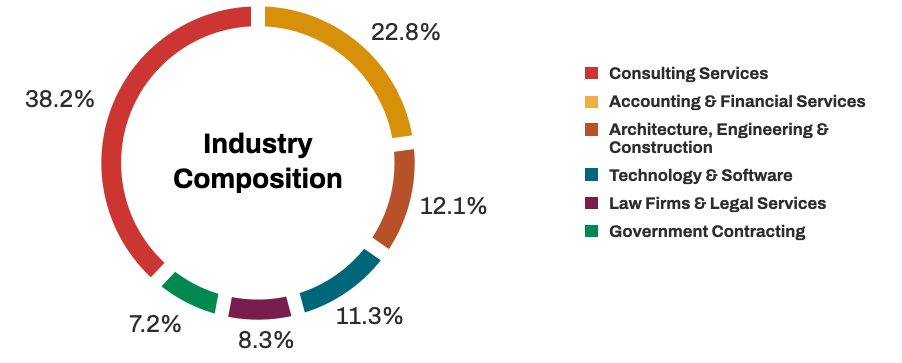
Participants represented firms of all sizes, and they conducted business in every region of the globe.
In the study, we grouped participating firms into three categories: High Growth (see definition in the section below), Low Growth (those that grew less than a 10% compound annual rate), and Average Growth (those that grew between 10% and 25%).
Get to Know the High Growth Firms
We define High Growth firms as those firms that achieve at least 25% compound annual growth over a three-year evaluation period. We contrast these firms against those that experienced little or no growth over the same time frame. This allows us to identify strategies and practices that are associated with faster growth and higher profits.
This year’s High Growth government contracting firms grew at a median rate of 45%—three times faster than their Average Growth peers. High Growth firms are also 59% more profitable, enjoying a median profit of 23%.
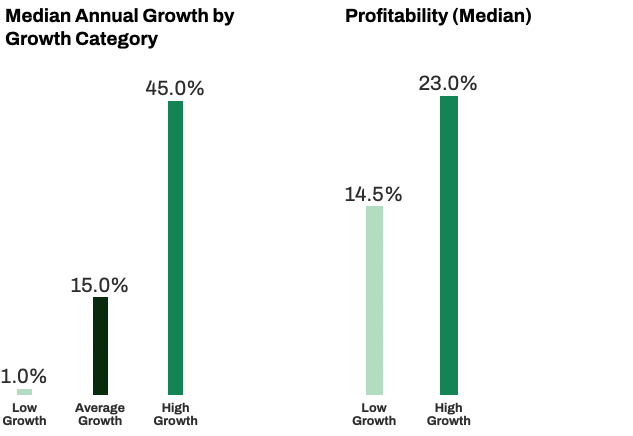
Next, let’s look at five takeaways from this year’s data and explore some of the reasons the High Growth cohort outperforms their peers.
1: High Growth Firms Spend Less on Marketing
High growth government contractors not only outperform the rest of the field, they do it while spending slightly less on marketing. The implication, of course, is that they are using their marketing budget more efficiently.
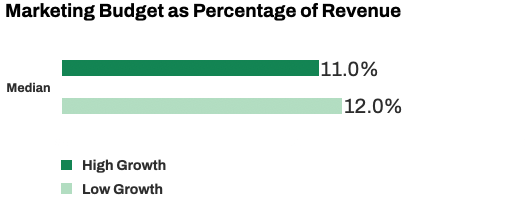
Below, we’ll explore a few reasons marketing may be more productive.
2: Top-Performing Firms Are Good at Learning What Works
Over time, High Growth firms have determined which marketing techniques work and which are a waste of time. In the chart below, we show you the five techniques these organizations use most often. The one they invest in most often—mentioned by almost three quarters of respondents—is business development materials. When the competition is tight, it pays to create pitch decks, quals materials, proposals and similar materials that paint your firm in the best light when pitching and closing the sale. This can mean investing in high-quality graphic design and writing talent, whether internal or outsourced.
Networking on social media and at live events are second and third. While these two activities require different skill sets, they achieve the same goal: creating a personal connection with potential buyers and contracting partners.
In a tie for fourth place are physical marketing collateral and using social media to promote thorough leadership content. In most professional services industries, printed marketing materials are becoming increasingly rare, but in the govcon arena face-to-face interactions with prospects are a critical part of the business development process. Branded materials and give-aways can remind new contacts about your firm after they leave the tradeshow or conference floor.
Producing content is a top priority of High Growth government contractors. So it comes as no surprise that promoting that content on social media would be a top marketing technique. Now, by social media we really mean LinkedIn. It is by far the most commonly used social media platform in the industry.
You can find the full list—as well as which techniques deliver the greatest impact—in the industry report.

3: Twice as Many High Growth Firms Engaged in M&A
In 2023, the year our data was collected, High Growth firms were more likely to be part of a merger or acquisition. About 1 in 5 of these organizations did so—about twice the rate of the Low Growth group. This activity may reflect some High Growth firms’ proclivity to scale through acquisition.
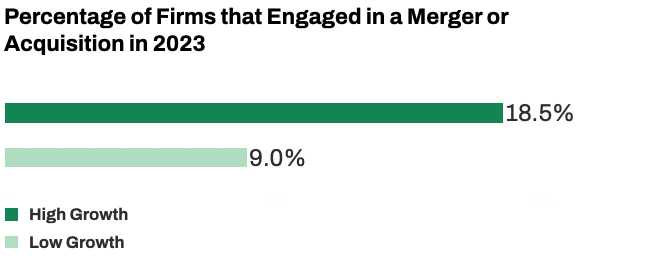
4: They Conduct Research More Frequently
Forty percent of High Growth firms produce structured research on their target audience. This is actually a bit less than the proportion of Low Growth firms that do it. But when they conduct research, High Growth firms are much more likely to do it frequently. In fact 70% do it at least quarterly, compared to 53% of the Low Growth group.
Why do research at all? One big reason: research is the best way to capture the changing habits and preferences of your buyers. Today’s marketplace is changing quickly, so organizations that can see those changes early have an advantage.
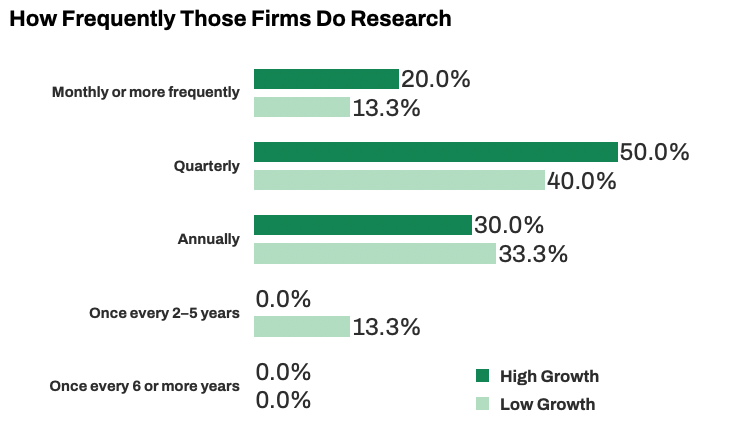
5: The Industry Struggles to Build a Strong Culture
Managing a remote workforce and a shortage of talent are government contractors’ top two business challenges. One of the best ways to attract top employees and keep them—whether they are in the office, working from home or deployed to a client’s workplace—is to build a warm, nurturing company culture. More than any other professional services industry we study, government contracting struggles with culture.
While High Growth firms do a better job than their Low Growth counterparts, only one in five top-performing firms give themselves high ratings when it comes to culture (a dismal 7.4% of Low Growth firms do the same). Clearly, there is a need to innovate and solve this problem. Many government contractors are different from firms in other industries. For instance, they often hire contract labor for specific projects. And employees often work outside the firm’s offices—sometimes for months at a time. But there are ways to build culture even when your people don’t see each other every day. Firms that want to attract and retain top talent would do well to explore their options or retain outside expertise to help them.
If you are curious what High Growth firms do to build a strong culture, see the government contracting industry report.

What Do You Do with this Information?
We hope that you have learned something new about the government contracting industry and how firms are approaching marketing today. But what do you do now?
The first step is to take this data back to your team and compare it to your own activities and performance. Then ask yourself a series of questions:
- Are you in the High Growth bracket? If not, you’ve now got a set of benchmarks to target.
- What marketing techniques do you favor, and how do they stack up against the high flyers? You may discover that you are prioritizing the wrong techniques or investing too little in them.
- How much do you budget for marketing? (Note: this should not include the cost of labor.) Is it more or less than the High Growth cohort? If substantially higher, you may want to consider looking for efficiencies to make your marketing more productive. Marketing automation software, for instance, might be an excellent way to reduce your labor costs while producing better performance.
- Do you do research? Or do you rely on anecdotal evidence and interactions with a few clients to shape your understanding of the marketplace. Research may be the best investment you can make.
- Is your company culture helping or hurting your ability to attract and retain talent? If it is hurting, think about what measures you could take to build morale and employee happiness. You might begin by asking the staff what one quality or benefit they most wish your organization would offer.
If you find there are a host of areas to improve, don’t try to tackle everything at once. Pick one initiative to test—perhaps in a limited way. If that bears fruit, roll it out in full and check your performance before moving on to the next one. Even one success can make a measurable difference!



